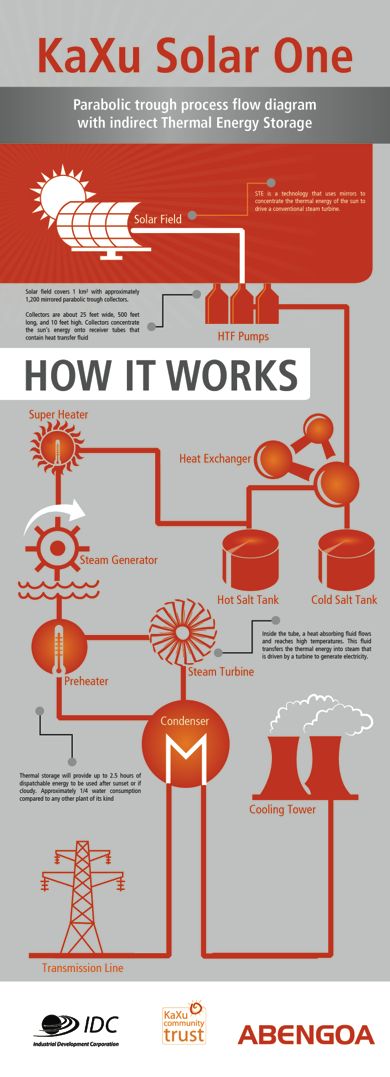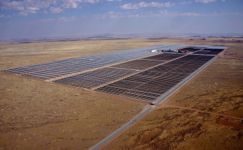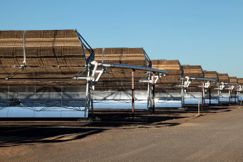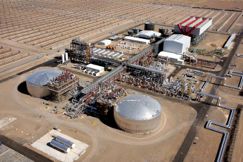Infrastructure
KaXu Solar One to ease pressure on SA's energy grid
Open skies
KaXu, which means "open skies" in the local Nama language, will add 100MW of electricity from the sun to the national grid, which is equal to about 320 gigawatt hours of electricity a year. "This is equal to the consumption of 80 000 houses, so serving more than 400 0000 South Africans. In practical terms, this is the consumption of all the households in Mossel Bay, Oudshoorn, Knysna and Swellendam combined," said Patel. The plant covers an area of three square kilometres. It is made up of 17nbsp;200 collectors; each collector has 10 modules; each module has 28 mirrors. There are a total of 336 000 mirrors on the plant. The mirrors track the movement of the sun. Importantly, STE technology allows electricity to be stored for two-and-a-half hours, which means power will be supplied to the national grid when it is needed most – at peak time after dark. And it saves 315 000 tons of carbon emissions per year, said Armando Zuluaga, the chief executive of Abengoa Solar, a partner of the project. Total investment was $891-million in KaXu, the largest parabolic trough project in the southern hemisphere, according to Javier Benjumea, the president of Abengoa Solar International Advisory Board. "It will generate power when the sun has set. It also offers increased flexibility in terms of storage. It offers the same electricity without carbon emissions and that is a game changer." KaXu Solar One was opened by Geoffery Qhena, the chief executive of the Industrial Development Corporation; Economic Development Minister Ebrahim Patel; Armando Zuluaga, the chief executive of Abengoa Solar; and Fadiel Farao, the chairman of the KaXu Community Trust. All are partners in the project. Qhena said the IDC recognised the key importance of the green economy, and had increased its focus in renewable energy as a means to reduce reliance on coal-generated power.Job creation
Developing the new industries had "facilitated job creation, the upliftment of rural communities, skills and industrial development," he said. The IDC's involvement had seen the industry become more competitive and attract interest from different players – demonstrating its role in de-risking the sector. KaXu had a capacity bigger than the installed capacity in the whole of Lesotho, said Patel, who spoke about other initiatives: on 3 March, the Kakamas Hydro Electric Power plant would be opened on the Orange River, adding 10 MW to the grid. "On [5 March], Abengoa directors will fly to Johannesburg to sign the closure agreement for the beginning of the next solar plant – next door. Xina will bring jobs to the community and bring power to the national grid and so help our country to build schools, build manufacturing and grow the economy."Koeberg equivalent
Already 33 renewable energy plants had been opened and by the end of the month, there would be 1 685 MW available – almost equivalent to Koeberg's entire output. "In 12 months we have been building plants that will generate almost as much as Koeberg. The difference is that Koeberg generates all the time." Coal was not forgotten though, and Patel spoke of the Medupi synchronising taking place on the day of KaXu's inauguration. "Over the next few months, we will make sure the system is stable, and we will bring 800MW of electricity into our grid. All of these are examples of the government working hard to solve the electricity problem." The total cost of KaXu came in at R7.9-billion investment, with about R1-billion coming from the Spanish group, Abengoa. The balance was supplied by the IDC, Nedbank RMB, Development Bank of Southern Africa, and the International Finance Corporation. KaXu is owned by Abengoa (59%), the IDC (29%) and the KaXu Community Trust (21%). The risk was carried by Abengoa, said Patel, which had put in its equity.Community trust
An important benefit was the value of the project to the rural area of Khai Ma. During construction, 4 500 jobs were created, 80% of them local. Now during operations, there are 80 permanent jobs, and South Africans are being trained to run the plant. Through the trust, the dividends would be invested in long-term projects that would benefit the community for generations to come, said Fadiel Farao, the chairman of the KaXu Community Trust. Projects would be in education, health, and skills development. "Big projects come and go," said Patel, "so we must see that they create something out of it so that generations to come can be helped." Finally, a project like this made a positive contribution to sustainability of life on planet. "If we burn coal and petrol all the time, we damage the environment and will kill opportunities for our children and the next generation. We can't destroy the earth to grow our economy. Renewable energy is a bit more expensive, but we have to invest in it. Because we use the power of the sun, it doesn't cause damage to our environment." The life of KaXu is 20 years, but there is an emphasis on growing local manufacturing of the components, which will allow the country to build a solar power manufacturing sector. "We pay more for renewable energy, so we must have a better return," said Patel. Renewable energy used to cost 100% more than coal-fired power; now that cost had dropped to 50% – and this was dropping all the time as more companies invested in new technology.How KaXu works

Source: IDC
 KaXu Solar One outside Pofadder in the Northern Cape. It is the biggest solar thermal electricity plant in the Southern Hemisphere. (Image: IDC)
KaXu Solar One outside Pofadder in the Northern Cape. It is the biggest solar thermal electricity plant in the Southern Hemisphere. (Image: IDC)
 A row of collectors, which track the sun, at KaXu Solar One in the Northern Province. (Image: IDC)
A row of collectors, which track the sun, at KaXu Solar One in the Northern Province. (Image: IDC)
 Salt storage facility at the KaXu Solar One plant, which is near Pofadder in the Northern Cape province. (Image: IDC)
Salt storage facility at the KaXu Solar One plant, which is near Pofadder in the Northern Cape province. (Image: IDC)
Related articles
- South Africa's action plan to keep the lights on
- Multimillion-rand renewal on the go in Khayelitsha
- Bold plan to tackle South Africa's energy crisis
- We will move forward, Zuma tells SA
- Can power ships ease SA's energy woes?
- SA developing reliable energy mix, Zuma tells Davos
- New solar plants in sunny Northern Cape
- Khi Solar One: renewable energy for the ages
- 'Significant progress' for SA's nuclear programme
- SMA Solar opens state-of-the-art factory in Cape Town
- SA Airways to test tobacco biofuel in 2015
- Nuclear power holds promise for SA
- South Africa opens its biggest solar plant




